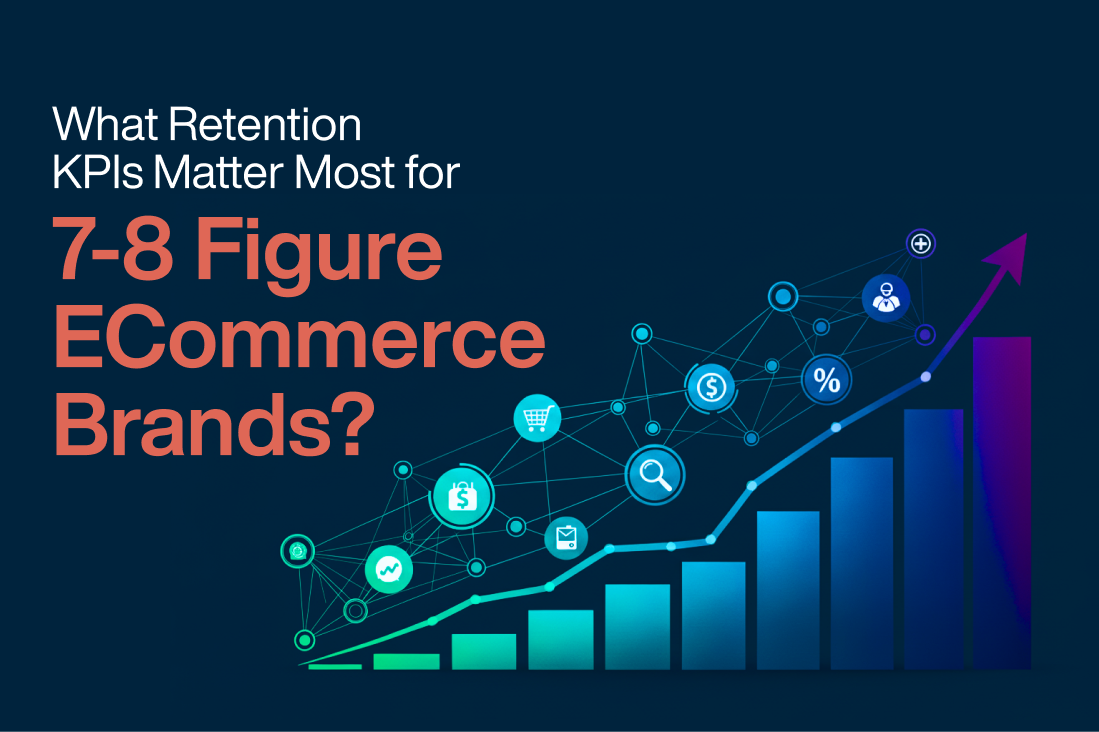What Retention KPIs Matter Most for 7-8 Figure eCommerce Brands?

For eCommerce brands crossing into 7-8 figures, acquisition alone is no longer enough to drive sustainable growth. At this stage, retention becomes the true profit driver but retention is not about “sending more emails” or “launching a loyalty program.” It is about measuring the right KPIs and using them to shape strategy.
In this blog, we will break down the most critical retention KPIs for scaling brands, explain why they matter, and show how they directly influence profitability and long-term growth.
Why Retention KPIs Are Different at Scale
Early-stage brands obsess over traffic, ROAS, and top-line revenue but once you hit 7-8 figures, the challenge shifts. Growth is less about adding more customers and more about maximizing the value of customers you already have.
This is why retention KPIs are so important. They allow you to see beyond vanity metrics and focus on long-term profitability, scalability, and cash flow stability. The right KPIs reveal whether your brand is building a loyal customer base or just chasing expensive one-time buyers.
The Most Important Retention KPIs for 7-8 Figure Brands
1. Customer Lifetime Value (CLV)
Why it matters: CLV is the ultimate retention metric. It tells you how much revenue an average customer generates over their entire relationship with your brand. The higher the CLV, the more profitable your acquisition spend becomes.
What to track:
- Average CLV across cohorts
- CLV by acquisition channel
- CLV by product line or customer segment
How to improve:
- Personalized lifecycle marketing (email, SMS, push)
- Cross-sell and upsell strategies
- Subscription models or bundling offers
2. Repeat Purchase Rate (RPR)
Why it matters: RPR shows what percentage of customers come back after their first purchase. A low RPR signals weak retention, meaning your acquisition dollars are being wasted on one-and-done buyers.
What to track:
- 30-day, 60-day, and 90-day RPR
- Repeat purchase frequency by product type
- Benchmark vs industry averages
How to improve:
- Post-purchase email flows and loyalty programs
- Timed replenishment reminders
- Tailored offers for second and third orders
3. Average Order Value (AOV)
Why it matters: Higher AOV boosts profitability without increasing acquisition costs. For scaling brands, raising AOV is often the fastest path to better margins.
What to track:
- AOV by customer segment
- AOV by purchase number (first vs repeat orders)
- AOV growth over time
How to improve:
- Bundles and tiered discounts
- Cross-selling at checkout
- Offering premium upsells or limited editions
4. Churn Rate
Why it matters: Churn measures the percentage of customers who stop buying within a defined timeframe. High churn erodes CLV and creates constant revenue resets.
What to track:
- Subscription churn vs one-time purchase churn
- Churn by acquisition channel
- Early-life churn (first 90 days after purchase)
How to improve:
- Personalized onboarding experiences
- Early engagement campaigns post-purchase
- Win-back flows to re-engage at-risk customers
5. Net Revenue Retention (NRR)
Why it matters: NRR looks at revenue growth from your existing customers, factoring in upsells, cross-sells, and churn. For 8-figure brands, NRR is a key indicator of compounding growth.
What to track:
- Percentage of revenue retained and expanded from existing customers
- Quarterly trends in NRR
- Impact of loyalty initiatives on NRR
How to improve:
- Introduce tiered loyalty rewards
- Encourage add-on purchases with each order
- Deliver ongoing value through community or membership models
6. Payback Period
Why it matters: Payback period measures how quickly you recoup acquisition costs from a new customer. A shorter payback period means faster profitability and stronger cash flow.
What to track:
- Average time to payback by channel
- Comparison of first-order vs lifetime payback
- Correlation between payback and RPR
How to improve:
- Incentivize second purchase within 30-45 days
- Promote subscriptions to accelerate payback
- Bundle offers to increase initial AOV
7. Engagement Rate Across Owned Channels
Why it matters: Retention relies heavily on owned channels such as email, SMS, and push. Engagement metrics indicate whether your customers are still connected to your brand or drifting toward churn.
What to track:
- Email open and click rates by lifecycle stage
- SMS engagement (CTR, opt-outs)
- Loyalty program participation rates
How to improve:
- Dynamic content personalization
- Segment customers by behavior and purchase history
- A/B test messaging and incentives
How to Use Retention KPIs Strategically
Collecting KPIs is not enough. The real value comes from integrating insights into decision-making.
- Align KPIs with financial goals: For example, if your goal is stronger cash flow, focus on reducing payback period. If your goal is profitability, focus on CLV and churn reduction.
- Segment data: Look at KPIs by channel, product, and customer segment to identify high-value vs low-value groups.
- Create feedback loops: Acquisition teams should target customers with the highest LTV potential. Retention teams should optimize onboarding and lifecycle flows to hit those metrics faster.
Final Takeaway
For 7-8 figure eCommerce brands, retention is not optional. It is the growth engine. The KPIs that matter most include:
- Customer Lifetime Value (CLV)
- Repeat Purchase Rate (RPR)
- Average Order Value (AOV)
- Churn Rate
- Net Revenue Retention (NRR)
- Payback Period
- Engagement on Owned Channels
By tracking and acting on these KPIs, brands can transform retention into a compounding growth driver. Acquisition brings customers in, but retention ensures they stay, spend more, and fuel long-term profitability.
Here at Wertec, this is exactly what we specialize in. Our team of retention experts partners with 7-8 figure DTC brands to design and optimize KPI-driven retention strategies that increase customer lifetime value, reduce churn, and unlock sustainable growth. If retention is where your brand needs to level up, we make sure the numbers work in your favor.